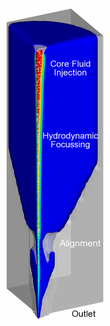Improved method for alignment and sorting of cells in flow cytometry
Here we present two new methods for flow cytometry and fluorescence-activated cell sorting (FACS).
The first invention relates to a nozzle aligning asymmetric cells or other materials within a fluid stream. The second invention relates to a method for sorting the samples contained within single droplets after the measurement.
The main improvement of both methods is that they impose less stress on the sorted material than conventional techniques. They are thus especially suitable for the so-called 'sexing' of spermatozoa or the sorting of other sensitive materials.
Challenge
Fluorescence-activated cell sorting is a powerful method to sort single cells or other materials, which are typically contained within droplets, based on certain characteristics. Here we address two common challenges with FACS:
(1) Prior to sorting the fluorescence of the sample is measured. Based on the result of the measurement the corresponding droplet is sorted into a certain bin. To achieve reliable measurements, it is crucial that each sample is measured under comparable conditions. This includes for asymmetric samples their orientation. Many samples sorted via FACS are sensitive to mechanical stress and might be damaged during the alignment process. A typical example are the sperm cells sorted during the so called 'sexing'. The available alignment methods reduce the vitality of these cells considerably.
(2) After alignment and after the measurement of the samples the sorting takes place. Typically the sorting is performed by deflecting the droplets within an electrical field. It is commonly believed that charging the droplets and deflecting them in an EM-field imposes further stress on the contained biological materials like sperm cells and decreases the quality of the sorted sample.
Our Solution
The two common problems with FACS mentioned in the previous section are addressed with two newly developed solutions:

Flow through nozzle (Source: Ulrich Klug)
(i) The alignment of asymmetric samples within a fluid stream prior to the separation into single droplets and the measurement of the fluorescence can be performed with a specially designed nozzle. The nozzle consists of two functional elements for producing a core stream and a sheath stream where the core stream contains the sample. The achieved separation of the core jet shaping and the hydrodynamic focusing reduces the stress imposed on the samples and keeps them in a healthy state.
(ii) Instead of performing the sorting within an electrical field, a short laser pulse can be used to vaporize a small amount of the fluid surrounding the sample. This inflicts an impulse on the droplet and deflects it. The droplets can thus be sorted into different bins without influencing the sample within the droplet.
Advantages
- Alignment of asymmetric cells
- Sorting into different containers without charging the droplets
- Significant reduction of the stress imposed on the samples
Applications
- Flow cytometry
- Fluorescence-activated cell sorting (FACS)
- Sexing of, for example, bovine sperm cells
Developmental Status
Both methods were successfully tested and the sorted cells were healthier than those sorted with conventional FACS techniques.
Patent Status
Laser sorting:
US-Patent US9034260B2
Nozzle:
US-Patent US9506911B2
Non-exclusive licenses can be granted.
Contact
Dr. Markus Muchow
Patentmanager Physik & Technik
E-Mail: This email address is being protected from spambots. You need JavaScript enabled to view it.
Tel.: +49 (0) 551 30 724 159
www.sciencebridge.de
Reference: CPA-1461-LZH and MM-2045-LZH
